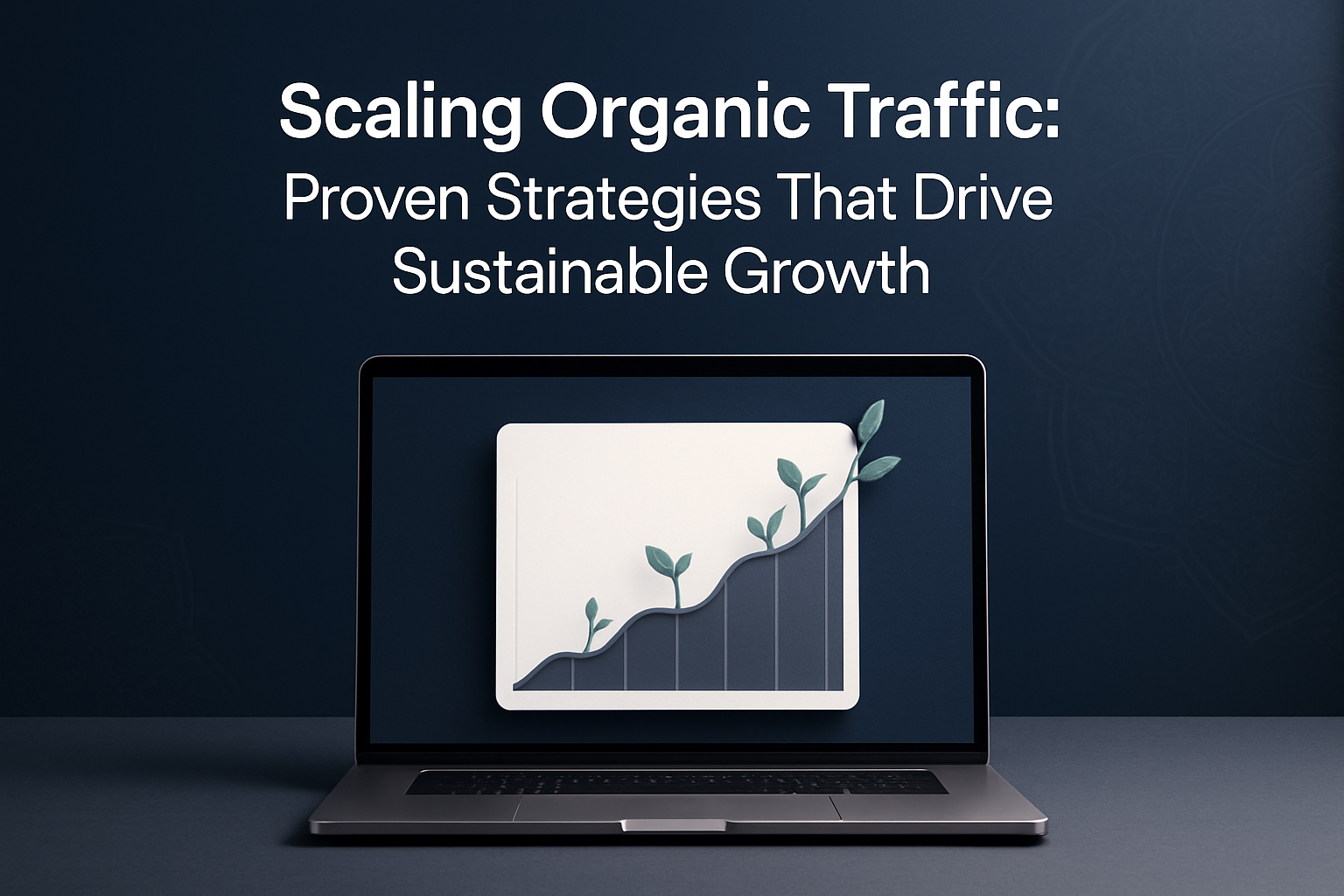
Table of Contents
Organic traffic remains one of the most valuable assets for sustainable business growth, with companies that prioritize it seeing 6x higher conversion rates than paid traffic sources. The challenge isn’t just getting traffic—it’s scaling it consistently while maintaining quality and relevance. Finding the right balance between quantity and quality when scaling organic traffic is critical for businesses looking to grow their market presence without proportionally increasing costs. This guide explores practical strategies for businesses looking to systematically increase their organic traffic while maintaining focus on high-intent visitors.
Understanding the Foundations of Scalable Organic Traffic
Building a sustainable approach to scaling organic traffic without expanding your marketing team requires strategic groundwork. Before implementing complex tactics, businesses must establish a solid foundation that supports long-term growth with minimal resource expansion.
Audit Your Current Traffic Sources
Begin your journey to scaling organic traffic without expanding your marketing team by conducting a comprehensive audit of existing traffic channels. Identify which content types and topics currently drive meaningful engagement and conversions. Using tools like Google Analytics or Creator’s automated SEO audit functionality, examine traffic patterns to determine:
- Which keywords generate high-intent visitors
- Content pieces with the highest conversion rates
- Pages experiencing traffic declines
- Technical issues limiting search visibility
This data-driven approach ensures your scaling efforts build upon proven success rather than assumptions. By understanding your current traffic ecosystem, you’ll identify optimization opportunities that maximize results without requiring additional team members.
Establish a Scalable Content Infrastructure
Scaling organic traffic without expanding your marketing team demands systems that facilitate content production at scale. This means:
- Creating standardized content templates and workflows
- Building a comprehensive keyword database organized by topic clusters
- Implementing AI-driven content creation tools to supplement human efforts
- Developing an editorial calendar with consistent publishing cadence
With platforms like Creator, businesses can automate significant portions of this infrastructure—from competitor research to content creation—allowing small teams to produce enterprise-level output. The goal is creating sustainable systems that grow with your business without proportional team expansion.
Set Realistic Growth Benchmarks
When scaling organic traffic without expanding your marketing team, establish measurable milestones that align with your resources. Avoid comparing your growth trajectory to competitors with larger teams or different business models. Instead:
- Set gradual, achievable monthly traffic increase targets
- Focus on quality metrics (time on page, conversion rate) alongside volume
- Measure team productivity improvements as automation is implemented
- Establish clear ROI metrics connecting traffic to business outcomes
Realistic benchmarks prevent burnout while creating accountability for sustainable growth. By focusing on steady progress rather than overnight results, smaller teams can achieve remarkable organic traffic expansion without additional headcount.
Automating Your SEO Workflow for Maximum Scalability
Scaling organic traffic without expanding your marketing team requires strategic automation of repetitive SEO tasks. Modern platforms now enable even small teams to achieve enterprise-level results through intelligent workflow optimization. Let’s examine how automation transforms SEO scalability.
Implement End-to-End SEO Automation
The most significant barrier to scaling organic traffic without expanding your marketing team is process fragmentation. Comprehensive automation platforms like Creator eliminate this hurdle by connecting previously siloed workflows. Rather than juggling multiple tools for technical audits, keyword research, and performance tracking, an integrated system creates a seamless process.
Begin by automating your technical SEO fundamentals. Site crawling, error detection, and optimization recommendations can run on predetermined schedules without human intervention. The data gathered automatically feeds into your content strategy, creating a self-improving system that gets smarter over time. This integration ensures that scaling organic traffic happens systematically rather than through disconnected efforts.
Streamline Content Production Without Sacrificing Quality
Content creation typically consumes the most resources when scaling organic traffic. AI-assisted writing tools now enable small marketing teams to produce significantly more content while maintaining quality standards. The key is establishing clear templates and guidelines that AI can follow consistently.
Set up automated content briefs that pull from keyword research, competitor analysis, and your site’s existing content gaps. These briefs should include searcher intent, target metrics, and content structure. When scaling organic traffic through automated content production, focus on creating reusable workflows rather than one-off pieces. This approach ensures consistency while dramatically increasing output capacity.
Automate Competitor Analysis for Continuous Improvement
Maintaining competitive advantage requires constant monitoring of industry changes. Automated competitor analysis tools track ranking fluctuations, content updates, and backlink acquisition without manual oversight. These insights feed directly into your strategy refinement.
Establish automated alerts for significant competitor movements, especially for your high-priority keywords. This proactive approach ensures you’re never caught off-guard by market shifts. When scaling organic traffic, this continuous intelligence gathering allows small teams to respond with the agility of much larger organizations. The cumulative effect is sustained growth without proportional team expansion.
Advanced Content Strategies That Scale Organically
Scaling organic traffic without expanding your marketing team requires smarter strategies, not just more resources. These advanced approaches help maximize your team’s impact while maintaining sustainable growth.
Develop Content Clusters Instead of Isolated Pieces
The days of random blog posts are over. Content clusters create a network effect that amplifies your organic reach. By organizing content around pillar topics with supporting articles, you establish topical authority that search engines reward.
For example, rather than publishing disconnected articles, build comprehensive resource hubs around your core offerings. Creator’s AI-powered platform can identify these opportunities and automate the planning process, helping you scale organic traffic without expanding your marketing team. This cluster approach creates internal linking pathways that distribute authority throughout your site and keep visitors engaged longer.
Focus on High-Intent Traffic Multipliers
Not all content delivers equal returns. High-intent traffic multipliers target users actively seeking solutions you provide. These include comparison pages, product alternatives, review content, and decision-stage resources.
By prioritizing these formats, you can scale organic traffic without expanding your marketing team while focusing on visitors most likely to convert. Creator’s platform automatically identifies these high-value opportunities based on competitor analysis and search intent patterns. The platform then generates comprehensive briefs and content that specifically addresses these high-conversion topics.
Implement Geographic and Vertical Expansion Methodologies
Scaling organic traffic without expanding your marketing team becomes possible when you systematically adapt existing content for new markets or industries.
Rather than creating entirely new content libraries, use these approaches:
- Vertical templating: Create adaptable frameworks that can be customized for different industries
- Geographic localization: Modify high-performing content for regional search patterns and cultural contexts
- Audience segmentation: Tailor messaging to different buyer personas while maintaining core topics
Creator’s automation capabilities excel here, allowing small teams to manage content across multiple segments simultaneously. The platform’s AI can adapt existing high-performing content to new verticals or locations while maintaining brand consistency and search relevance.
Measuring and Optimizing Your Organic Traffic Growth
Scaling organic traffic without expanding your marketing team requires rigorous measurement and continuous optimization. When done correctly, these processes become the engines that drive sustainable growth—letting you achieve more with your existing resources.
Establish Comprehensive Performance Tracking Systems
The foundation of effective SEO scaling lies in proper measurement. Start by implementing a robust analytics infrastructure that tracks not just traffic volume but traffic quality metrics. Creator’s performance dashboard gives you real-time visibility into key indicators like organic sessions, conversion rates, and keyword position changes without requiring manual data gathering.
Set up tracking for both leading indicators (keyword rankings, backlink acquisition) and lagging indicators (organic conversions, revenue). This comprehensive approach to scaling organic traffic without expanding your marketing team means you’ll identify opportunities and issues before they impact your bottom line.
Develop Iterative Optimization Frameworks
Successful organic growth isn’t a set-it-and-forget-it endeavor. Create a systematic approach to testing and improving your content and technical SEO elements. This means establishing:
- Regular content audits that identify underperforming assets
- A/B testing protocols for titles, meta descriptions, and content formatting
- Prioritization frameworks for addressing technical issues
Creator’s AI-powered platform automates much of this process, suggesting optimizations based on performance data without requiring additional headcount. The key to scaling organic traffic is making optimization an ongoing process rather than a reactive effort.
Align Organic Traffic Goals with Business Outcomes
Traffic for traffic’s sake delivers little value. Ensure your measurement framework ties organic performance directly to business metrics that executive teams care about. This means tracking:
- Revenue attribution from organic channels
- Customer acquisition costs compared to other channels
- Lifetime value of customers acquired through organic search
When scaling organic traffic without expanding your marketing team, this alignment helps secure resources and demonstrate the value of your SEO investments. Creator’s integration capabilities connect SEO performance to your CRM and business intelligence tools, creating a clear line of sight from rankings to revenue.
Conclusion
Scaling organic traffic requires a strategic approach that balances increased content production with systematic quality control. By implementing automated workflows, focusing on high-intent traffic, and continuously measuring performance, businesses can achieve sustainable organic growth. For businesses looking to scale efficiently, platforms like Creator offer an integrated approach to automating the entire SEO process—from technical audits and competitor analysis to content creation and performance tracking. This comprehensive automation is especially valuable for SMBs, B2B SaaS companies, and D2C brands that need to maximize organic growth without expanding their teams or juggling multiple tools. Remember that sustainable traffic scaling isn’t just about doing more—it’s about building systems that allow you to work smarter. By implementing the strategies outlined here, you’ll be well-positioned to grow your organic traffic in a way that directly supports your business objectives.
Ready to scale your organic traffic without scaling your team or tools? Discover how Creator’s AI-powered SEO platform can automate your organic growth journey.



